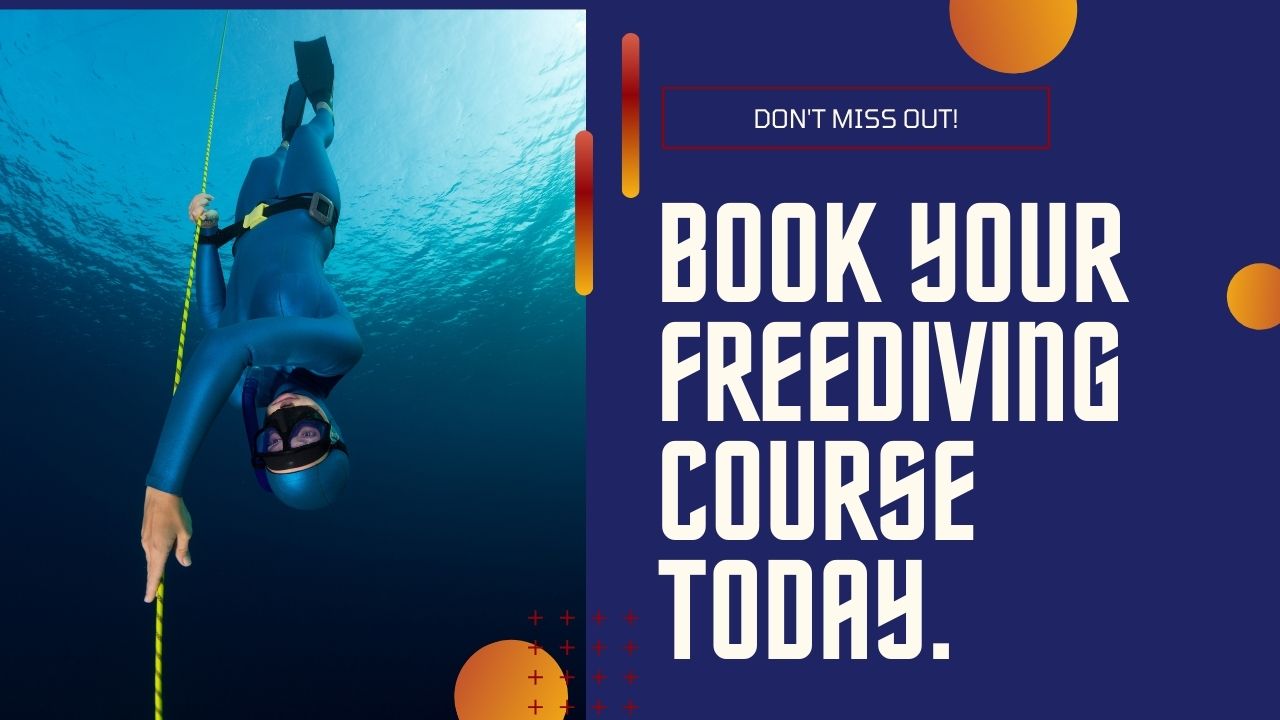You have 0 product(s) in your cart.
Abyss Scuba Diving
Spearfishing Essentials: Master Sustainable Techniques For Ocean Bounty

Spearfishing Essentials: Master Sustainable Techniques for Ocean Bounty
Learn the art, equipment, and safety protocols necessary to pursue this sustainable and selective method of fishing. Gain insight into how to minimise your ecological impact while maximising the thrill of the underwater hunt. This guide delivers the essentials for an informed and responsible spearfishing experience.
Key Takeaways
-
Spearfishing combines ancient traditions with modern technology, requiring skill, knowledge of marine behavior, and a commitment to sustainable practices that respect the marine environment.
-
Spearfishing is acknowledged as a sustainable form of fishing with minimal environmental impact, based on its low capture rate, selectivity, and adherence to local regulations, promoting marine conservation.
-
The future of sustainable spearfishing is promising, with the potential for increased use of eco-friendly materials, stricter conservation guidelines, and technological innovations to minimize environmental impact.
The Essence of Spearfishing
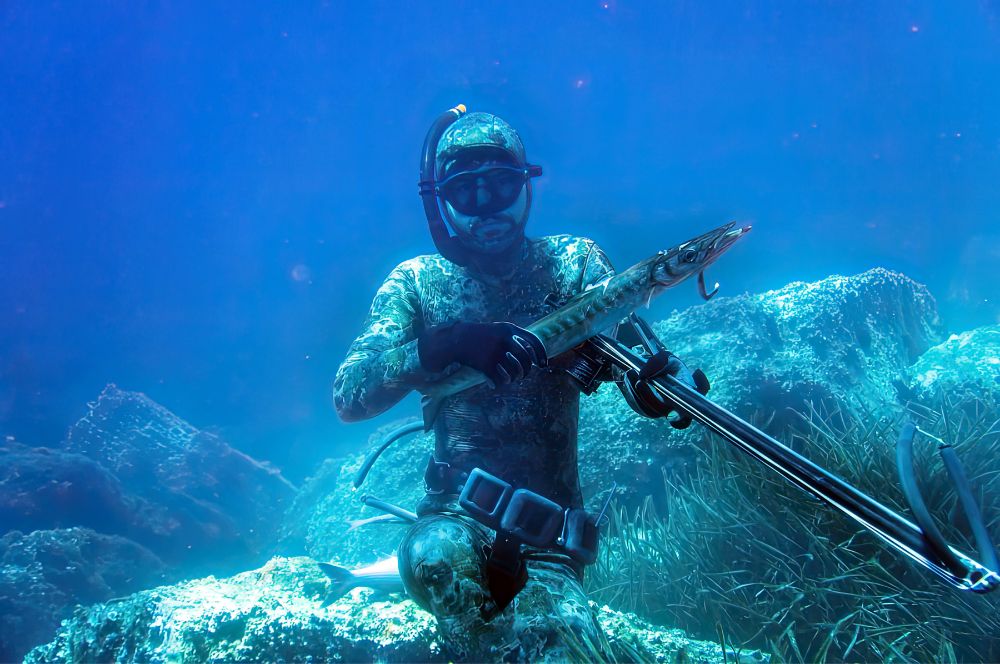
Spearfishing is no ordinary fishing method. It’s an ancient practice, a testament to our ancestors’ survival skills and ingenuity. It’s an art form that has stood the test of time, evolving with the modern world yet remaining deeply rooted in tradition. Today, spearfishing has embraced the advances of technology, incorporating modern underwater swimming gear and spearguns into its age-old practices.
However, spearfishing is not just about the equipment we use or the strategies we employ. At its core, spearfishing is a unique experience of underwater hunting, a blend of ancient traditions and modern practices. It involves:
-
immersing oneself in the rhythm of the ocean
-
comprehending the complex behaviours of reef fish
-
committing to sustainable fishing practices that respect marine life and its environment.
Above all, spearfishing revolves around the hunt. The majority of spearfishers practice shore diving, targeting ocean structures like reefs directly from beaches or headlands. It’s a pursuit that requires skill, patience, and respect for the marine environment. Every dive is a new exploration, every catch a reflection of the spearfisher’s knowledge of the sea and its creatures.
Still, to truly understand the spirit of spearfishing, one must experience the excitement of the hunt firsthand. It’s this exhilaration, this profound connection with the sea, that truly defines the heart of spearfishing.
The Thrill of the Hunt
The thrill of the hunt is an intrinsic part of why many embrace spearfishing. It offers more than just the pursuit of catching fish. It’s about forging a deep, personal connection with the sea, a bond that brings a profound sense of well-being. The thrill escalates when hunting big pelagic species. Understanding their complex behaviors and migration patterns adds an element of challenge and excitement that is hard to match.
Moreover, the spearfishing community enhances this thrill through competitions and mentorships. Participating in spearfishing competitions offers a platform to learn, grow, and share experiences with fellow spearfishers. Similarly, partnerships with experienced spearfishers provide newcomers with knowledge while fostering respect for marine life.
The thrill of spearfishing goes beyond mere adrenaline; it’s a continuous adventure of learning, honoring, and appreciating the ocean’s offerings.
Spearfishing and Marine Stewardship
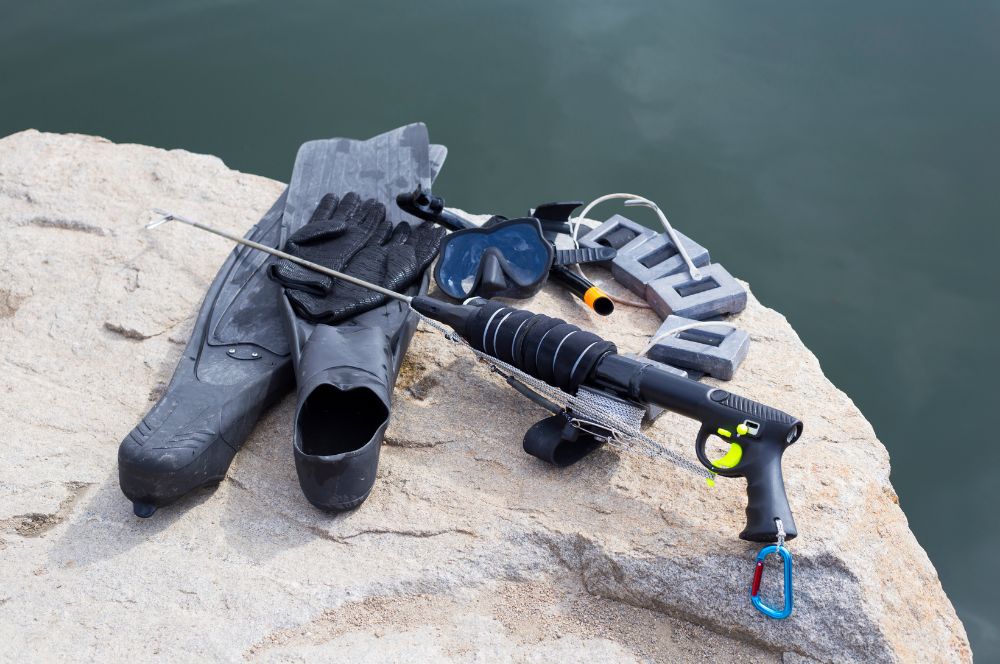
The relationship between spearfishing and marine stewardship is profound. It’s a bond that reflects the commitment of spearfishers to the ocean’s health and the sustainable methods they employ. Spearfishing is celebrated as a sustainable fishing method due to its minimal environmental impact. It requires no bait, poses little threat to the marine environment, and avoids harm to non-target species.
When compared to other fishing methods, the spearfishing catch rate is significantly lower. This lower fishing effort makes the overall impact of spearfishers on fish populations relatively small. Moreover, the use of spearguns allows spearfishers to selectively harvest fish by quantity, size, and species, thereby enabling more control over their impact on marine life.
Spearfishers also contribute to marine conservation and ethical fishing by adhering to local regulations. This includes following bag limits and size restrictions and being knowledgeable about protected species in their fishing areas. These practices demonstrate a deep commitment to marine stewardship, showcasing the importance of sustainable spearfishing within the broader context of marine conservation.
In the subsequent subsections, we’ll explore various facets of spearfishing and marine stewardship, discussing topics ranging from gear selection to sustainable practices and conservation initiatives.
Gear Guide
Spearfishing necessitates specialized equipment, each piece tailored to augment the spearfisher’s efficiency and safety under the water. The primary tool for spearfishing is the speargun, powered by either elastic bands or compressed gas. The choice of speargun depends on the target fish, water clarity, and shooting range.
There are also alternative spearfishing tools such as polespears and Hawaiian slings. The length of these tools can impact maneuverability and suitability to the environment. Alongside these, spearfishers use low-volume masks to enhance their field of view and make deep diving easier. These are often complemented by specially designed wetsuits with camouflage patterns for stealth.
Further essential gear for spearfishing includes:
-
Weight systems to counteract the buoyancy of wetsuits, aiding in descent
-
Long swimfins for faster ascents during freedive spearfishing
-
Buoy and floatline systems, which serve as a safety signal to boats, a mechanism to subdue large fish, and a storage method for catches
Each piece of gear plays a vital role, contributing to a successful and safe spearfishing experience.
Techniques and Safety
For any spearfisher, it is imperative to be proficient in fundamental spearfishing methods and safety precautions. One of the fundamental safety rules is to always dive with a buddy and use the ‘one up, one down’ system. This means that while one diver is underwater, the other stays at the surface, ready to provide assistance if necessary. Familiarizing oneself with emergency procedures is also important to assist in blackout or samba situations.
Some fundamental spearfishing methods to be proficient in include:
-
Proper breath-holding techniques
-
Efficient finning and swimming techniques
-
Accurate aiming and shooting techniques
-
Proper handling and dispatching of fish
By mastering these methods and following safety precautions, you can ensure a safe and successful spearfishing experience.
Spearfishing also involves:
-
Maintaining awareness of predators like sharks and understanding how to respond during encounters
-
Respecting other water users and managing spearfishing equipment safely in public spaces to ensure everyone’s safety
-
Adapting spearfishing techniques and safety measures to the specific diving environment, such as scuba diving where legal
When hunting in open waters, additional safety considerations like the buddy system and signaling devices are necessary. Strong swimming skills and advanced freediving techniques are crucial for targeting open ocean species. Maintaining safety in spearfishing is not solely about adhering to rules; it involves comprehending the sea, honoring its creatures, and staying ready for all scenarios.
A Commitment to Conservation
Spearfishers are not just hunters; they are also dedicated conservationists. Most spearfishers target sustainable fisheries and limit their catches to what they need, aligning with a broader goal of avoiding overfishing and species endangerment. Freediving spearfishers, in particular, tend to have a profound knowledge and cultural connection to the ocean, reinforcing their commitment to its preservation.
Ethical behaviours, such as refraining from taking fish that will not be eaten and respecting wildlife, are key characteristics of sustainable spearfishing. Spearfishers are often involved in:
-
Educational outreach, raising awareness of the importance of conservation
-
Advocating for marine protected areas
-
Targeting invasive species in spearfishing tournaments
-
Aiding in ecological research
-
Restoring marine ecosystems
This commitment to conservation extends to the competitive sphere as well.
Moreover, recreational spearfishers contribute valuable ecological observations that can be utilized in scientific research efforts and aid in conservation. By targeting invasive species, spearfishers help rebalance marine ecosystems. Through their actions, spearfishers contribute significantly to preserving marine life, demonstrating the profound connection between spearfishing and marine conservation.
Sustainable Spearfishing Practices
Sustainable spearfishing practices play a vital role in minimising ecological impact and promoting responsible harvesting. Spearfishing is a sustainable practice that avoids unintended catch and ecological disturbance thanks to its precise targeting of individual fish. Timing spearfishing activities to coincide with specific periods throughout the year helps ensure fish populations have the opportunity to recover and thrive.
Spearfishers can also contribute to ecosystem health by focusing their efforts on capturing invasive species that otherwise disrupt natural marine habitats. Compared to other fishing methods, spearfishing minimizes ecological impact, boasting benefits such as less bottom disturbance from anchoring, reduced litter, and virtually no bycatch.
Technological advancements have further enhanced sustainable spearfishing practices. These advances provide detailed knowledge about the fish’s history from catch to consumption, supporting the sustainability and traceability of spearfished products. These practices demonstrate spearfishing’s commitment not only to marine stewardship but also to the future of sustainable fishing.
Understanding Regulations and Ethics
Understanding regulations and ethics is an integral part of responsible spearfishing. Spearfishers must be aware of and comply with local size and bag limits for various fish species and spearfishing areas. This includes understanding the ethical implications of their activities and the importance of species protection.
Many spearfishing regulations reflect the input from the spearfishing community, emphasizing their dedication to conservation and sustainable spearfishing methods. These regulations are not just rules to be observed, but a testament to the spearfishing community’s commitment to preserving marine ecosystems.
In the subsequent subsections, we’ll investigate the significance of comprehending local regulations, catch limits, and bag limits, and examine the ethical aspects in spearfishing.
Local Laws and Bag Limits
Local regulations and bag restrictions are vital in controlling spearfishing practices. These fishing regulations ensure sustainable and ethical fishing, preventing overfishing and ensuring conservation. Size limits, such as minimum and maximum lengths, ensure only appropriately sized fish are harvested, aiding in the protection and sustainability of fish stocks.
Given the restrictions in many locations, it’s essential to check local regulations before spearfishing, especially in sensitive environments like estuaries. Spearfishers can employ spearfishing apps and local resources such as spearfishing clubs to stay informed about species limits and comply with regulations effectively, thereby contributing to ethical spearfishing practices.
Ethical Considerations
The ethical aspects of spearfishing go beyond adhering to rules and venture into the sphere of individual accountability. True ethical spearfishing is characterized by only shooting fish that will be consumed, reflecting responsible and sustainable practices. Responsible spearfishing also involves identification of the correct species and ensuring it meets size regulations.
An ethical kill is another crucial aspect of spearfishing. It involves ensuring the immediate immobilization of the fish to prevent suffering and reduce the risk of attracting predators.
Ultimately, the ethics of spearfishing are fundamentally about the legacy left for future generations, ensuring that the enjoyment and availability of marine resources are preserved.
Impact of Spearfishing on Fish Stocks
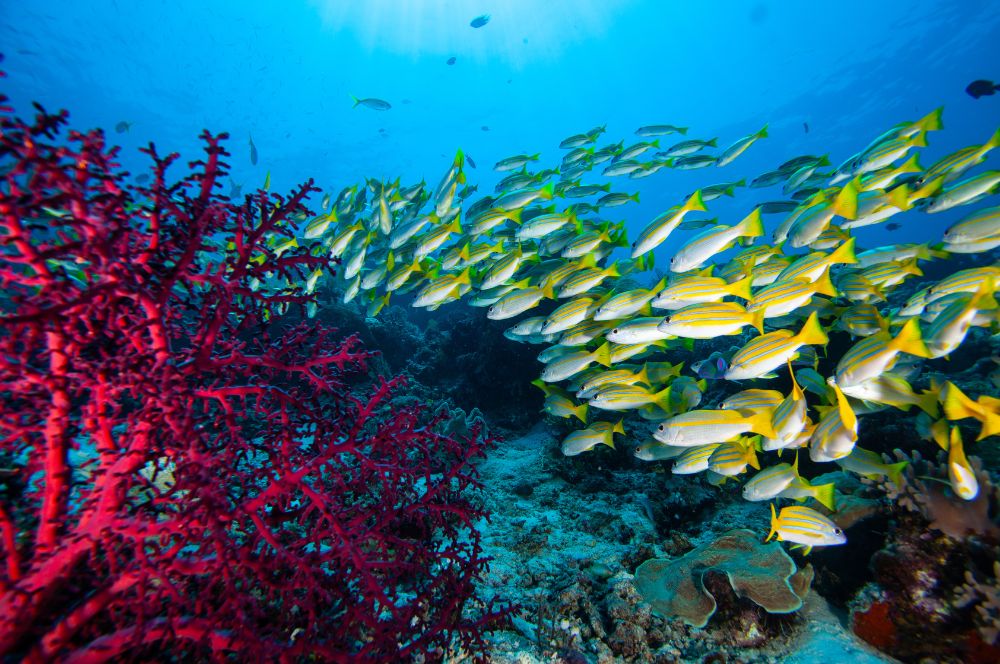
Despite being a sustainable method, it is essential to comprehend the impact of spearfishing on fish populations. Studies indicate spearfishing can lead to a significant reduction in both the density and size of target fish species. For instance, the density of coral trout on the Great Barrier Reef saw a 54% reduction following spearfishing allowances. Monitoring fish counts in these areas can help assess the impact on the fish population and ensure the sustainability of various fish species.
Despite these impacts, the overall capture rate of fish via spearfishing, a form of recreational fishing, is less than 1% when compared to other fishing techniques, suggesting a relatively lower environmental impact. However, spearfishing’s selectivity for larger individuals can result in a decline in the reproductive capacity of populations, since larger fish tend to be more fertile.
Spearfishing often targets species that are mid to high-trophic level carnivores, which can have cascading effects on the ecosystem. Additionally, the practice of selectively targeting keystone species, such as herbivorous parrotfish, is critical for maintaining coral-dominated reefs, including coral reefs. This underscores the critical nature of spearfishing management for reef health.
In the subsequent subsections, we will delve into the selectivity of spearfishing and its repercussions, and examine the Blue Groper incident as a case study.
Selectivity and Its Consequences
Spearfishing is a highly selective form of fishing, focusing on specific quantities, sizes, and species of fish with practically no by-catch. However, this selectivity can have ecological consequences. The preference for targeting larger individuals in spearfishing can alter fish populations’ size structure, affecting sex ratios in species with sex-changing life histories and reducing the presence of larger, genetically valuable individuals.
Selective spearfishing practices can also lead to shifts in community composition and dynamics, affecting ecosystem function and resilience. This selectivity can induce behavioral changes in targeted fish species known as ‘timidity syndromes’. These changes, along with shifts in community composition, underscore the need for responsible spearfishing practices to maintain ecological balance.
Case Study: The Blue Groper Incident
The narrative of the Blue Groper underscores the adverse effects of non-sustainable spearfishing. In several unfortunate instances, spearfishers lacking experience and adequate training have been involved in the demise of this iconic species, with incidents reported in various New South Wales locations, notably around Cronulla.
These incidents have consequently harmed the reputation of the spearfishing community committed to responsible fishing practices. The actions of a few individuals have tarnished the image of the majority of spearfishers who adhere to sustainable practices.
The Blue Groper incident serves as a stark reminder of the broader consequences of unsustainable spearfishing activities on marine ecosystems and the responsible spearfishing community.
Spearfishing in Different Waters
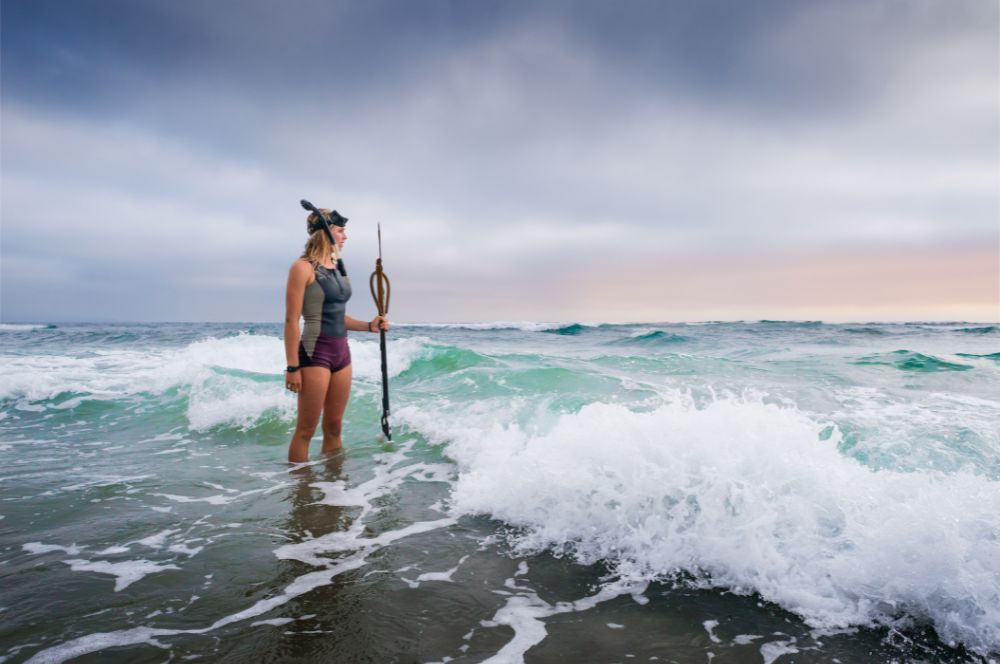
Spearfishing is a multifaceted sport adaptable to different water environments, each presenting distinct challenges and rewards. From the calm estuaries to the turbulent open ocean, spearfishing adapts to the rhythms of these diverse waters. Whether you’re navigating the dense kelp forests of the North Eastern Pacific or the clear waters of a freshwater lake, spearfishing requires a deep understanding of the environment and the species that inhabit it.
Estuaries are partly enclosed coastal bodies of saltwater, offering ideal conditions for spearfishing. These habitats host species that either reside exclusively in this environment or pass through seasonally. On the other hand, kelp forests, particularly those formed by Giant Kelp (Macrocystis Pyrifera), are unique environments for spearfishing, commonly found along the coast of the North Eastern Pacific, South Africa, Australia, and New Zealand.
Freshwater environments, such as rivers, lakes, or dams, offer a different set of challenges for spearfishing. Visibility in these environments can be quite poor, making spearfishing more challenging and less common than in marine habitats. Despite these challenges, freshwater spearfishing offers a unique experience, requiring different equipment and tactics due to the different behavior and habitats of freshwater fish species.
In the subsequent sections, we will discuss the challenges faced in coastal spearfishing and the thrilling experiences of open ocean spearfishing.
Coastal Challenges
Coastal spearfishing presents its own unique challenges, including strong surf and reduced visibility. These conditions require durable and simple gear like hard floats and short floatlines for safety. Identifying and planning for suitable entry and exit points is crucial to ensure safe and effective shore dive spearfishing.
Weather and ocean conditions should be assessed prior to coastal spearfishing to prevent unnecessary risks and ensure a favorable environment for diving. Targeting species like crayfish, giant trevally, and jewfish in coastal waters involves tactics such as stealth and quiet movement, with techniques like grouper calling used to attract snapper and grouper.
A comprehensive understanding of fish behavior, habitat preferences, and seasonal patterns enhances the spearfisher’s ability to locate and catch prey in coastal regions. Each coastal environment presents unique challenges, but with the right knowledge and skills, they can be successfully navigated.
Open Ocean Adventures
The open ocean offers a different kind of adventure for spearfishing enthusiasts. It’s a vast expanse where spearfishers can target large pelagic species such as dogtooth tuna, wahoo, and yellowfin tuna, often using techniques like chumming and using flashers to simulate a bait ball. Timing open ocean spearfishing trips to optimize seasonal and water clarity conditions is crucial for species such as barramundi and enhances the opportunity for successful hunting.
Divers can encounter a diverse array of pelagic species in the open ocean, differing from those found near coastlines, making each trip a unique adventure. Due to factors such as water depth and the unpredictable nature of the marine environment, open ocean spearfishing requires a higher level of skill and stringent safety measures.
To reach the offshore reefs or ocean structures where open ocean spearfishing takes place, enthusiasts typically use boats, kayaks, or even jet skis. Careful navigation and acute awareness of one’s surroundings are essential in the expansive open ocean to prevent disorientation and ensure a safe return.
Innovations in Spearfishing
The spearfishing realm is dynamic, consistently evolving and welcoming technological advancements and innovations that enrich the spearfishing experience. Carbon fiber spearguns have grown increasingly popular due to their strength-to-weight ratio, lifetime durability, and resistance to saltwater corrosion. New spearguns are being designed with hydrodynamic shapes to minimize drag and improve maneuverability underwater.
Spearfishing gear now often includes smart technology, such as built-in dive computers that aid in navigation and log dives. GPS-enabled buoys and dive watches now allow spearfishers to mark successful dive spots and track their movements while underwater.
In the upcoming subsections, we will examine the most recent technological tools in spearfishing and contemplate the future prospects of sustainable spearfishing.
Technological Tools
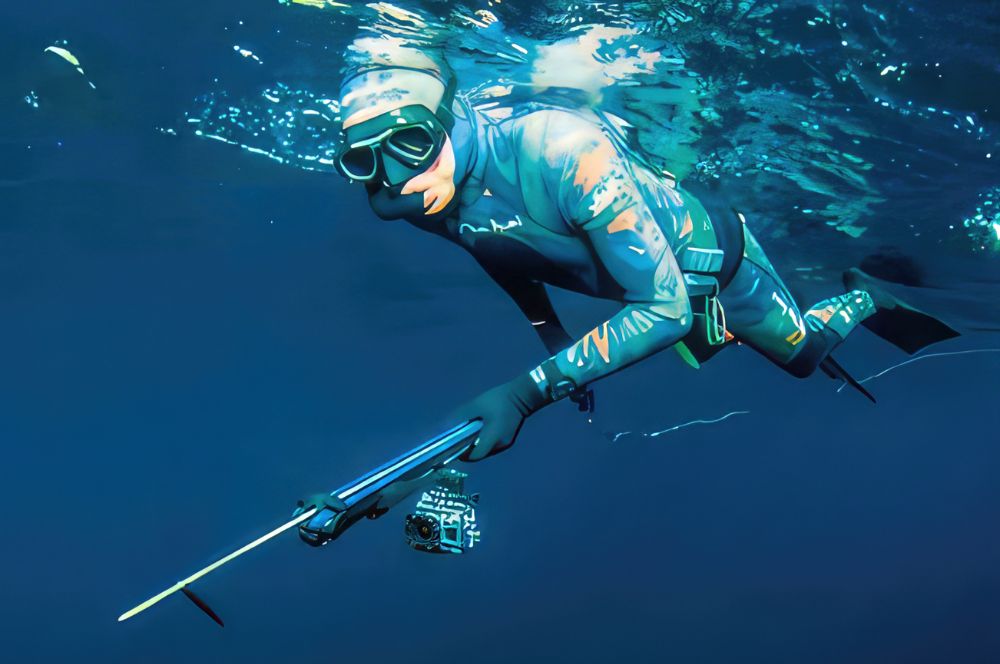
Underwater cameras have become indispensable tools in spearfishing, providing spearfishers the ability to record their dives and catches in high-definition. Affordable options like the Campark ACT74 Action Camera allow even beginners to capture their spearfishing experiences in 4K. For those seeking a user-friendly camera, the Coleman C40WP offers a lightweight construction with the ability to capture full HD videos and 20-MP stills.
The Olympus Tough TG-6 caters to spearfishers diving in extreme conditions, offering robust features like freeze-proofing and enhanced underwater colour balances. Advanced spearfishers can utilise the Paralenz Vaquita with its comprehensive features such as GPS, gyroscope, and accelerometer for detailed underwater videography.
Essential features for spearfishing cameras include high waterproofing levels and shockproof capabilities. Cameras like the Paralenz Vaquita can dive up to 115 feet and withstand drops, demonstrating the importance of durability in spearfishing technology.
Future of Sustainable Spearfishing
Looking ahead, the future of sustainable spearfishing looks promising. Future sustainable spearfishing practices may include:
-
Increased use of gear manufactured from sustainable materials, contributing to a lesser environmental footprint
-
Implementing stricter regulations and guidelines to protect marine ecosystems and fish populations
-
Promoting education and awareness about sustainable spearfishing practices
-
Encouraging the use of alternative fishing methods that have less impact on the environment
This shift towards eco-friendly practices represents a commitment to the environment and aligns with the broader goals of marine conservation.
As the spearfishing community continues to grow, so does its commitment to sustainable practices. By embracing technological innovations and prioritising sustainability, spearfishers can ensure that the sport remains an enjoyable and ecologically responsible pastime for future generations.
Spearfishing Culture and Community
Spearfishing transcends being merely a sport or a leisure pursuit; it’s a culture, a community united by a mutual love for the ocean and the exhilaration of the hunt. Spearfishing competitions serve as a platform for community engagement, allowing spearfishers to showcase their skills, connect with peers, and participate in social activities. These events, like the Canada Cup in New South Wales, established in 1952, symbolise the rich tradition and ongoing enthusiasm within the spearfishing circle.
Competitions like the Eden 3 Way State Championship and the South Coast Spearfishing Championships enhance the social fabric by offering challenging venues for spearfishers to gather and celebrate their passion for the sport. Regular events such as the Taylor Shield, running since the 1960s, demonstrate spearfishing’s ability to encourage consistent community participation and cultivate personal skill development over time.
In the following sections, we will discuss the construction of a responsible spearfishing community and the value of learning from seasoned spearfishers.
Building a Responsible Spearfishing Community
Building a responsible spearfishing community is crucial for the sport’s sustainability and the preservation of marine ecosystems. Spearfishers can contribute to this by:
-
Sharing observations with scientists
-
Engaging in citizen science projects
-
Helping to extend research efforts
-
Bridging the gap between science and recreational activities
By collaborating with scientists and participating in citizen science projects, spearfishers can play a vital role in the conservation and management of marine resources.
Educating others about the sustainability and selectivity of ethical spearfishing can help dispel common misconceptions and promote the positive aspects of the sport. Building a community dedicated to conservation can amplify the efforts of individuals and make sustainable spearfishing practices more widespread and effective.
The integration of junior categories in spearfishing competitions promotes responsible fishing practices to younger generations, helping build a responsible community for the future. Spearfishers can educate others by promoting the benefits and best practices of spearfishing, establishing a culture of sustainability within the sport.
Learning from the Experienced
Learning from experienced spearfishers is an invaluable part of becoming a proficient spearfisher. Freedive.co.za provides a comprehensive year-long mentorship program that covers a vast range of knowledge and skills necessary for spearfishing. The mentorship program spans various skill sets including:
-
Freediving
-
Spearfishing
-
Understanding oceanic environments
-
Diving site selection
-
Boating
-
Equipment maintenance
Experienced mentors in spearfishing can significantly reduce beginners’ learning curve and time spent on trial and error, leading to a safer and more effective approach to the sport. Passion and open-mindedness are emphasised in spearfishing, reflecting the importance of these attitudes in learning and in respecting marine ecosystems.
Summary
In conclusion, spearfishing is a fascinating blend of tradition, technology, and respect for the marine environment. It’s a sport that calls for skill, patience, and a deep understanding of the ocean and its inhabitants. By embracing sustainable practices, adhering to local laws and regulations, and learning from experienced mentors, spearfishers can ensure their activities contribute positively to marine conservation. As we look towards the future, the ongoing commitment to sustainability and innovation within the spearfishing community promises a bright future for this thrilling pastime, ensuring it remains an enjoyable and ecologically responsible activity for generations to come.
Frequently Asked Questions
What is the danger of spearfishing?
The most common danger of spearfishing is Shallow Water Blackout (SWB), which can occur within 3-6 meters (10-20 feet) of the surface, often caused by hyperventilation. Be cautious and avoid over-breathing while holding your breath during spearfishing to prevent SWB.
Where can you spear fish in NSW?
In New South Wales, spearfishing enthusiasts can enjoy the sport in various marine locations, with the exception of protected areas such as marine parks or sanctuaries where spearfishing may be restricted or prohibited.
Is it Ethical to spear fish?
When approached responsibly and with a focus on sustainability, selectivity, and minimizing suffering, spearfishing can be considered an ethical method of fishing. It is important for spearfishers to adhere to certain guidelines and ethics to ensure sustainability.
What is the sustainable fishing method?
Spearfishing, when conducted by skilled and experienced spearfishers, emerges as the most environmentally friendly method of fishing available.
Why is spearfishing considered a sustainable fishing method?
Spearfishing is considered a sustainable fishing method because it is highly selective, targeting specific quantities, sizes, and species of fish, reducing unintended catch and ecological disturbance, and it does not require bait, which poses little threat to the marine environment and avoids harm to non-target species.
RELATED POSTS
-
Learn to Freedive: Your Guide to the…
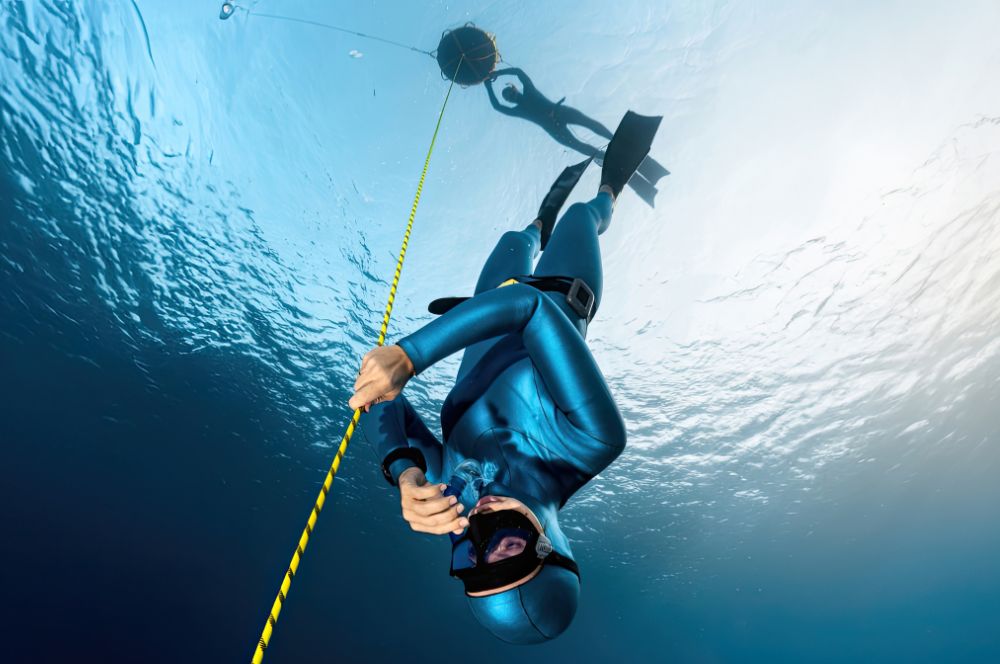
Learn to Freedive:…
Learn to Freedive: Your Guide to the Freediver Course for Fun Dive into a world of tranquillity, serenity, […] -
Sydney's Thriving Freediving Community:…
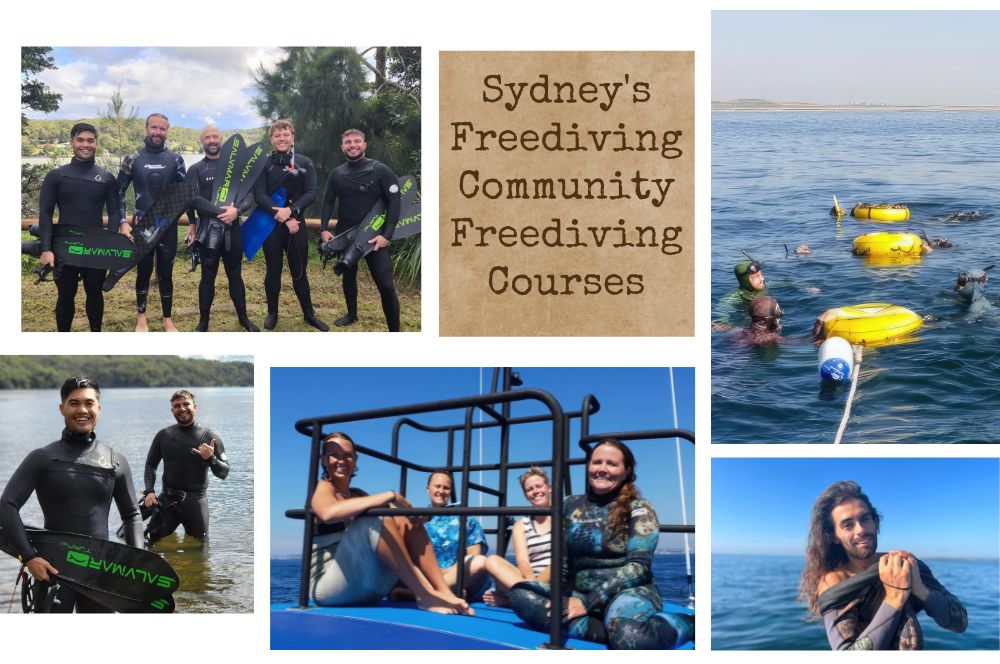
Sydney's Thriving Freediving…
Sydney's Freediving Community: An Introduction Welcome to the exhilarating world of freediving in Sydney! […] -
Unlock the Benefits of Neck Weight…
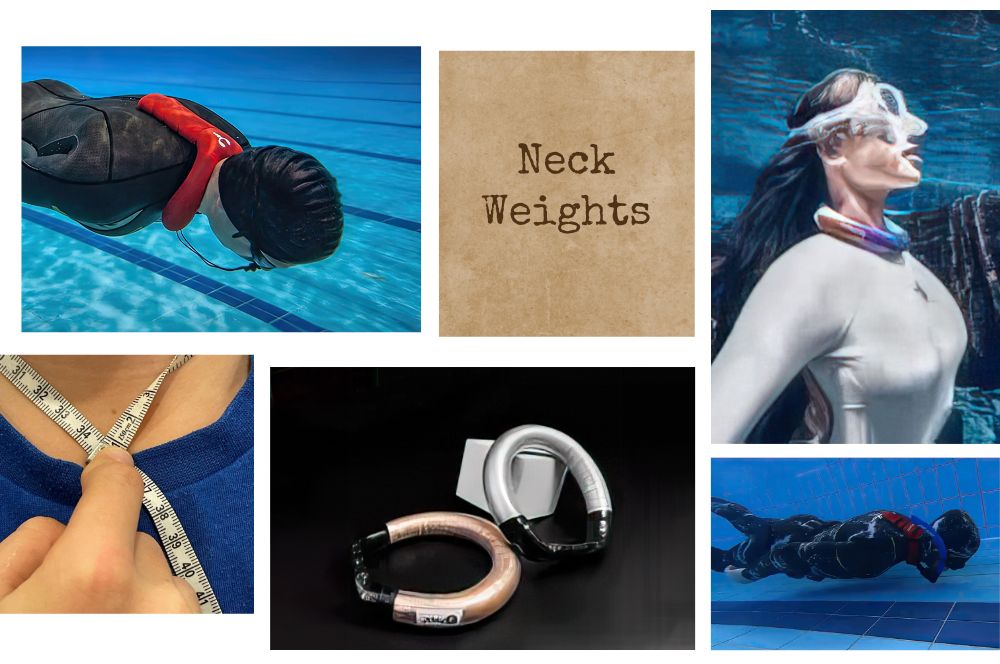
Unlock the Benefits…
Unlock the Benefits of Neck Weight Freediving Freediving is an extraordinary sport that tests your physical […] -
What Is the Ideal Weight for Freediving?

What Is the Ideal Weight…
What Is the Ideal Weight for Freediving? Freediving is a thrilling yet challenging sport, pushing the limits […]
Recent Posts
